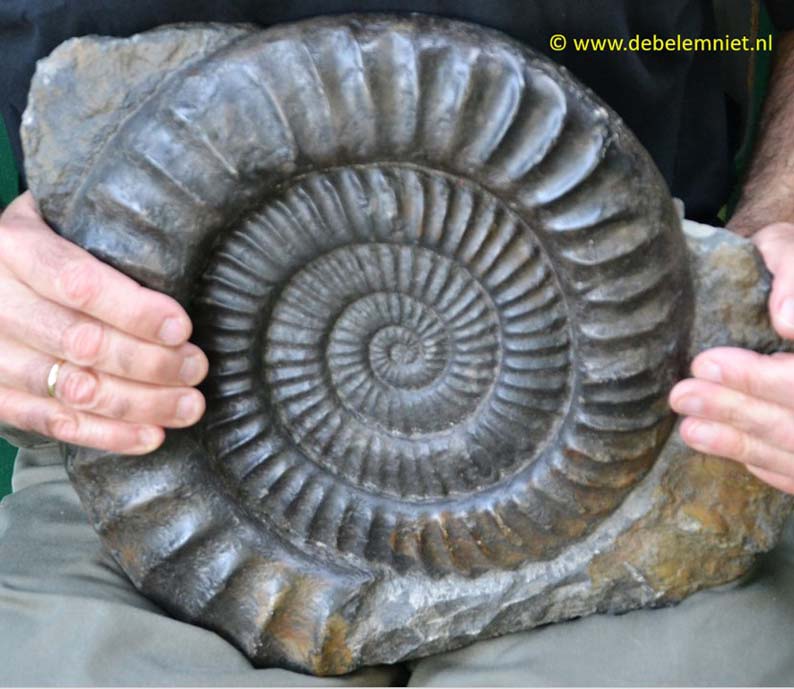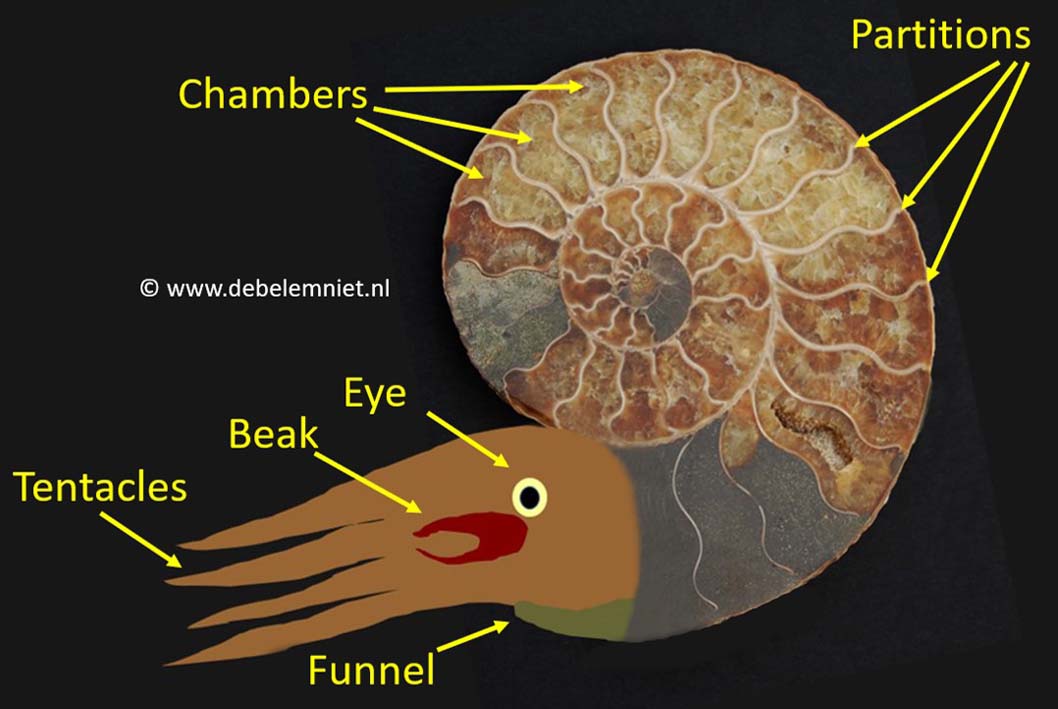Ammonites
What is an
ammonite?
Ammonites (Ammonoidea) are an extinct subgenus of squids (Cephalopoda). The animals have tentacles around their mouths that resemble arms. The oldest ammonites date from the Lower Devonian period, which began about 416 million years ago. They became extinct around the end of the Cretaceous period, about 65 million years ago. That means they existed on Earth for more than 350 million years. During that time, several thousand different species have developed. Their size ranged from less than a centimetre to more than 2½ meters. With some imagination, you could see the horn of a ram in the coiled shape of most ammonites. They owe their name to this similarity because the Egyptian god Ammon was often depicted with the head of a ram. In addition to the ammonites with this coiled shape, anomalous shapes also occurred during the Cretaceous (images 1 and 4). Examples include Scaphites, Hamites, Baculites (image 1) and Turrilites.
 |
| Image 1. Left: all kinds of ammonites. Right: Baculites. The pin is 3 cm. |
Today, an animal closely related to the ammonites still lives in the sea. It is the nautilus that occurs in tropical waters. By looking at the nautilus we get an idea of how the ammonites lived.
 |
 |
| Image 2. A large ammonite (Arietites solarium). | Image 3. Simple scheme of an ammonite. |
If we judge from the construction and lifestyle of nautiluses, we could say the following about ammonites. Ammonites must have been intelligent and fast-moving carnivores that actively hunted their prey. They could probably swim like nautiluses. Most ammonites have a kind of coiled shell that is divided into chambers. These rooms are separated from each other by partitions : the suture lines. These suture lines have all kinds of whimsical patterns that differ from species to species. They are an important identification feature of ammonites. Each chamber is in fact a growth stage of the animal. The ammonite itself lived in the largest, last formed chamber of the shell. Every time the animal 'outgrew its shell', a new, larger chamber had to be made. The other rooms were filled with gas. This allowed the animal to regulate its buoyancy. We could compare that a little bit with the ballast tanks of submarines. A tube (sipho) connected the anterior chamber to the posterior chambers. With this sipho the animal could possibly descend or ascend by pumping more or less water into its shell.
 |
| Image 4. Not all types of ammonites have the familiar coiled shape. This specimen is probably a type of ammonite from the genus Australiceras. |
So the actual animal was in the front chamber. On the outside of the shell we see the 'head' with fleshy tentacles or catching arms around a set of sturdy jaws that resemble a parrot's beak. The tentacles serve to grab and hold prey. Next to the tongue is a grater (the radula) covered with sharp teeth that serves to finely grate food. Here, in addition to the anus and genital opening, we also find the animal's eyes. The ammonite was given the impetus to move by forcefully squirting water out through a hollow, funnel-shaped tube (funnel or hyponome). By doing so the animal shot backwards. The direction of movement could be changed by turning the funnel.
 |
| Image 5. Ammonites still partially in their original matrix. |
• Fossiele cephalopoden van Nederland. The chapter ‘Inleiding Nederlandse Cephalopoden’ is written by René H.B. Fraaije, Philip J. Hoedemaeker and Adiël A. Klompmaker. Published as Staringia no. 13 in 2012 by the Nederlandse Geologische Vereniging (Dutch Geological Society).
• The article Ammonieten by P.J. Hoedemaeker and J. Stemvers - van Bemmel appeared in the first issue of 1996 of the Stichting Geologische Activiteiten.
• Fossielen in kleur van J.F. Kirkaldy was published by Moussault’s Uitgeverij in Amsterdam in 1972.
 |
| Image 6. If you pay close attention, you can sometimes encounter ammonites in floors made of natural stone (limestone) (left and middle). Ammonites can also sometimes be found in erratic stones. This erratic stone from the Rhine (right) was found near De Steeg in Gelderland (Netherlands). The pin is 3 cm. |
